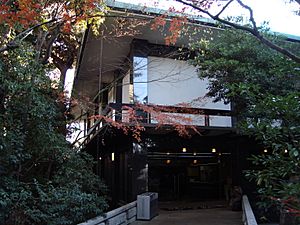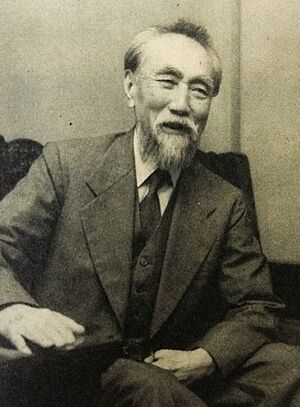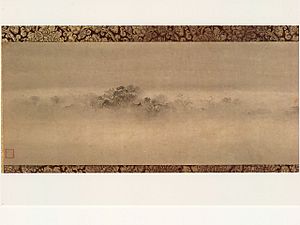Hatakeyama Memorial Museum of Fine Art facts for kids

Hatakeyama Memorial Museum
|
|
| Established | October 1964 |
|---|---|
| Location | 2-20-12 Shirokanedai Minato-ku Tokyo 108-0071 Japan |
| Type | Art museum |
| Public transit access | Takanawadai Station |
The Ebara Hatakeyama Museum of Art is a special museum in Tokyo, Japan. It first opened in October 1964. This museum is a private collection, meaning it was started by an individual, not the government.
In October 2024, the museum got a new name: the Ebara Hatakeyama Museum of Art. It reopened on October 5, 2024. Before that, it was closed for some important updates and improvements.
Contents
Museum History
The museum was founded by Hatakeyama Issē. He was born in 1881 and passed away in 1971. Mr. Hatakeyama was also the person who started a big company called Ebara Corporation.
In 1937, Hatakeyama Issē bought the land where the museum now stands. This land used to belong to a count named Terashima Munenori. Hatakeyama then moved an old guest house from a place called Hannyaji in Nara to his new property. He named this guest house "Hannyaen." In 1943, he held a special tea ceremony there to celebrate.
Mr. Hatakeyama loved a type of Japanese theater called Noh. He had practiced Noh since he was young. Because of this, he even bought his own private Noh theater. He put it together again on his property. The museum's collection includes some beautiful Noh costumes.
In 1964, Hatakeyama Issē built the museum right next to his home. He wanted to keep his amazing collection safe for many years. He also wanted to share it with the public through exhibitions. This way, people could enjoy the art, and researchers could study it.
Tea Houses at the Museum
The museum building has a tea house called Shō-an. There are also several tea houses in the garden that people can rent. These include Sara-an, Sui-an, Meigetsuken, Shin zashiki, Jōrakutei, and Bishamondō. Once a year, the museum offers a special guided tour. This tour lets visitors see these beautiful tea houses up close.
Amazing Art Collections
The museum puts on four different exhibitions every year. The collection mainly focuses on items used in Japanese tea ceremonies. But it also includes many other old artworks from Japan, China, and Korea. These artworks include paintings, special writings called calligraphy, pottery, and items made with lacquer.
The museum has about 1,300 art pieces in total. Six of these are so important that they are called National Treasures. Another 32 items are known as Important Cultural Properties of Japan.
National Treasures
Here are some of the National Treasures you can find at the museum:
- Letter of Fujiwara no Sukemasa: This is a very old letter called Rirakuchō (離洛帖). It was made in Japan using ink on paper. It became a National Treasure on June 28, 1956.
- Evening bell from mist-shrouded temple: This painting is thought to be by an artist named Muqi Fachang. It's called Enji banshō-zu (煙寺晩鐘図 伝 牧谿筆). It was painted with ink on silk in China during the Southern Song period (1127–1279).
- Painting of Apple blossom: This painting is believed to be by Zhao Chang. Its name is Ringo kazu (林檎花図 伝 趙昌筆). It's a painting on silk from the Southern Song period in China.
- Fragmentary Leaves of Zenki-zu: This artwork shows parts of a Zen monk's life. It's thought to be by Indara and has writing by Chushi Fanqi. It was made with ink on paper in China during the Yuan dynasty.
- Letter of Daie Sōkō: This is a special writing by Daie Sōkō (1089–1163). It's called Daie Sōkō bokuseki sekitoku (大慧宗杲墨蹟 尺牘). It was made with ink on paper in China during the Southern Song period.
- Box with butterfly inlay: This is a beautiful box called Chō raden makie tebako (蝶螺鈿蒔絵手). It's made of lacquerware and has shiny mother-of-pearl designs of butterflies. It was made in Japan during the Kamakura period.
Important Cultural Properties
The museum also has many Important Cultural Properties, including:
- Bokuseki of Yuanwu Keqin: This is a special writing by Yuanwu Keqin from February 12, 1128. It's known as Engo kokugon bokuseki (Ken'en 2-nen 2-gatsu 12-nichi) (圜悟克勤墨蹟 (建炎二年二月十二日)). It became an Important Cultural Property on May 25, 1939.
- Bokuseki of Nanso Shisetsu: This writing by Nanso Shisetsu is from the fall of 1342. It's called Nanso Shisetsu bokuseki (Shisei 2-nen aki) (南楚師説墨蹟 (至正二年秋)).
- Portrait of Hideyoshi Toyotomi: This is a painting of a famous Japanese leader, Hideyoshi Toyotomi, on silk cloth. It became an Important Cultural Property on May 6, 1936. Its full name is Kenpon chakushoku Toyotomi Hideyoshi-zō (Keichō 3-nen 8-gatsu san) (絹本著色豊臣秀吉像〈慶長三年八月日賛〉). It has a note from August 1598.
Tea Cups
The museum has several famous tea cups, including:
- "Kōshin" Koido jawan (江岑)
- "Denchū" Ao idojawan (田中)
- Amamori-jawan (雨漏茶碗)
- Nicknamed "Matsudaira kohiki" Kohiki-jawan (松平粉引)
Other Artworks
- Painting: Kiyotaki gongen gazō (清滝権現画像)
- Decorative Art: A handscroll of "Kokin Wakashū" with designs of flowers from the four seasons. It's called (金銀泥四季草花下絵古今集和歌巻).





